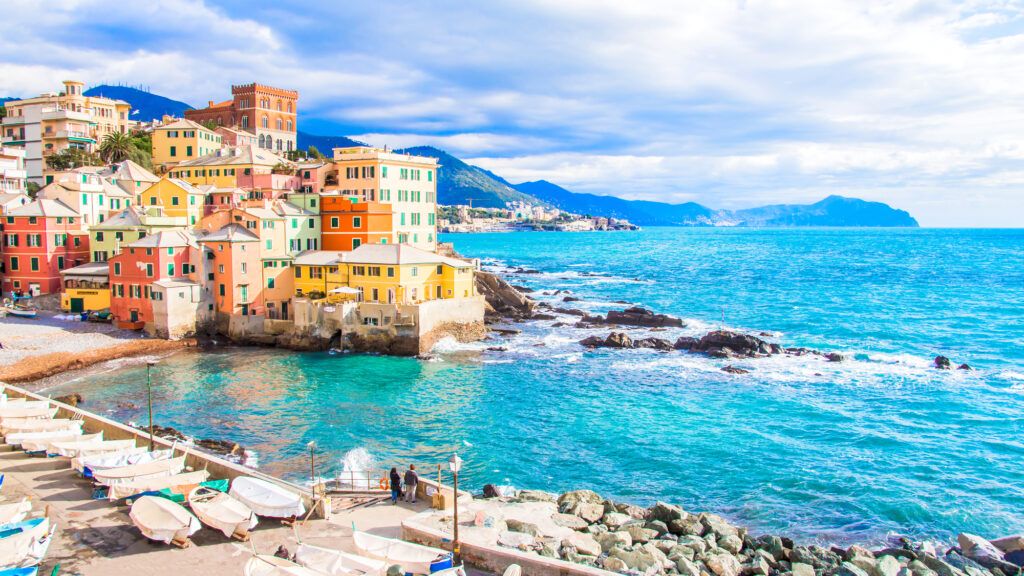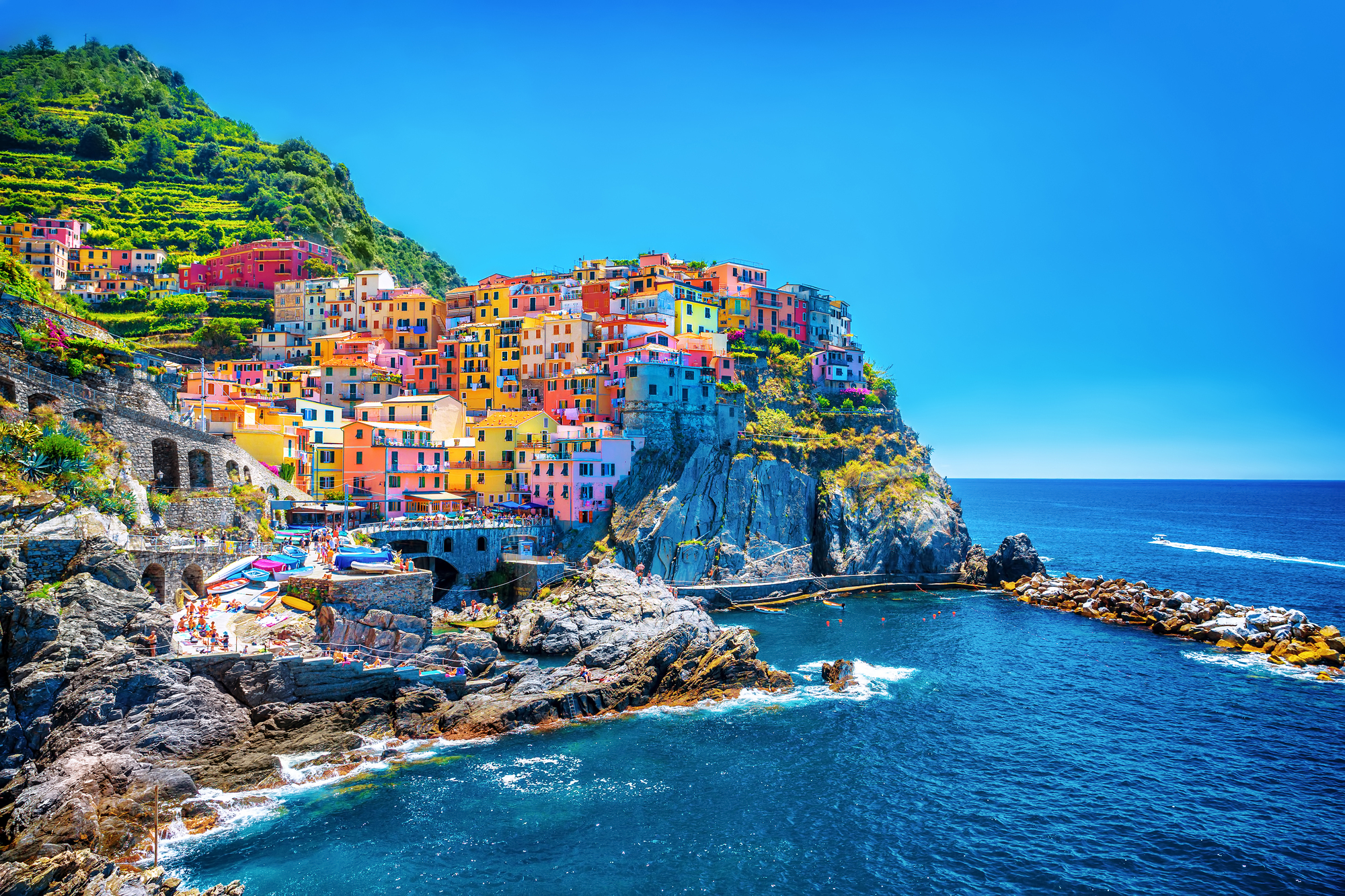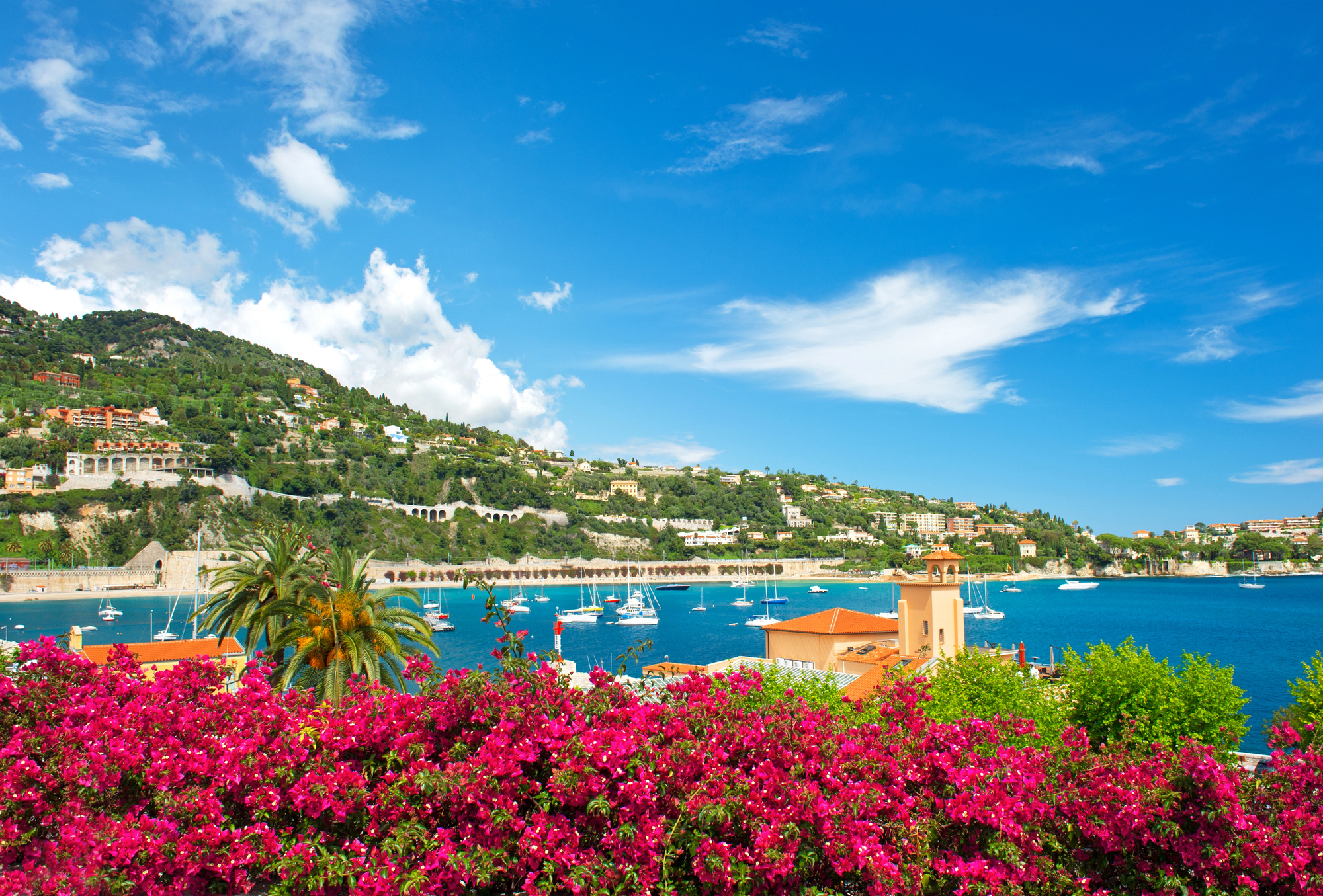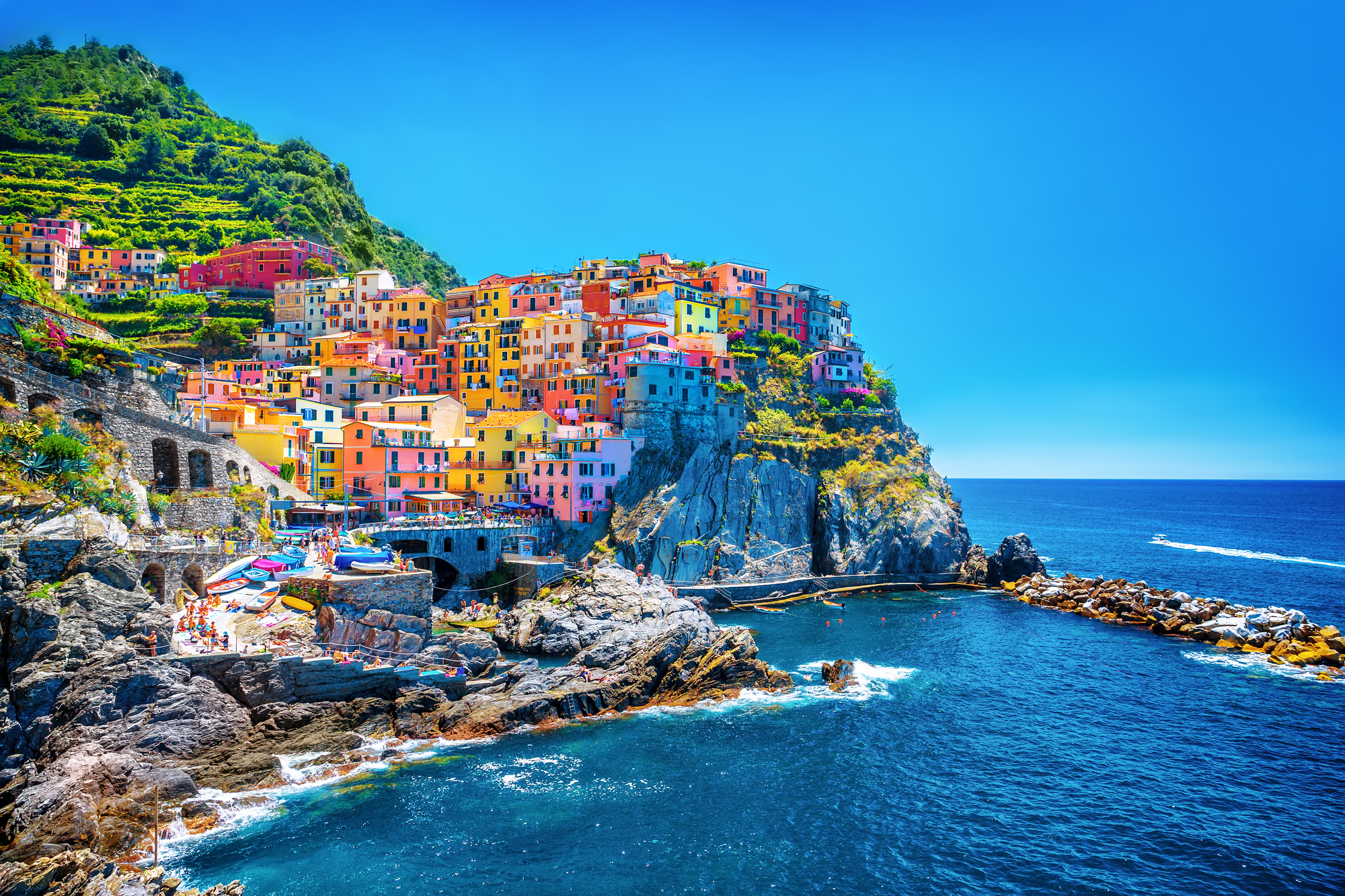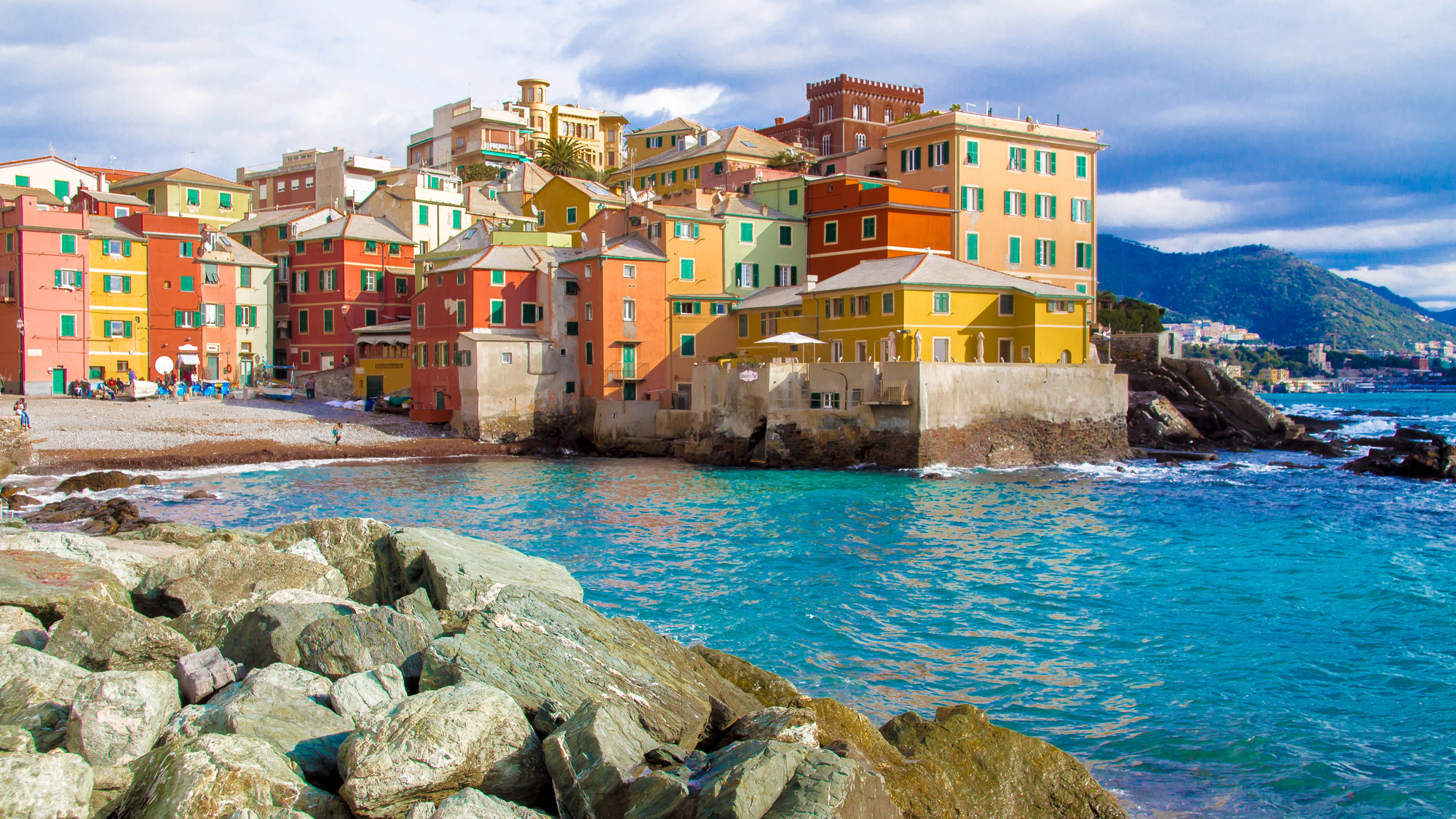Genoa’s coastline brings a beach experience you might not expect on the Italian Riviera. There’s a mix of urban beaches tucked right into the city and hidden coves scattered along Liguria’s dramatic shoreline. If you love the sea, you’ll find something that fits your vibe. The best beaches near Genoa blend the city’s cultural richness with the natural beauty of the Mediterranean, so you can wander historic streets one moment and dip your toes in clear blue water the next.
Genoa’s beaches feel more authentic than the famous resorts further down the Riviera. You’ll usually see more locals than tourists soaking up the sun. Some spots are small pebble coves, others have sandy stretches that are just right for laying out.
Get a discount of 15% to 70% on accommodation in Genoa! Look for deals here:
Genoa Hotels, Apartments, B&Bs
It’s pretty straightforward to reach these beaches, whether you’re based in Genoa or coming from nearby towns. Public transportation connects the city center to most of the coast, so you can easily split your day between cultural sights and swimming in the Ligurian Sea.
Why Visit Genoa’s Beaches?
Genoa’s coastline gives you a mix of city convenience and Mediterranean charm. The beaches here offer relaxation, culture, and natural beauty all at once—honestly, it’s a combination you don’t get everywhere on the Italian Riviera.
Unique Coastal Setting
Genoa sits squeezed between mountains and sea, which creates some seriously dramatic scenery for your beach day. The Ligurian coast here is all about pebbly shores and rocky cliffs instead of endless sand, giving the beaches a character of their own.
Most beaches aren’t packed like Portofino or Cinque Terre, so you’ll have more space to stretch out. You can pick between free public beaches and beach clubs (stabilimenti balneari) that rent loungers, umbrellas, and offer a few extra perks.
The Ligurian Sea’s clear blue water is perfect for swimming. Many beaches are close to the city center, so you can easily jump from museums to the seaside.
History and Culture by the Shore
Genoa’s beaches sit right next to centuries of maritime history. When you’re lounging by the water, you might spot historic buildings and the UNESCO-listed old town nearby.
Traditional Ligurian architecture—those colorful houses—lines the waterfront. Some beach clubs have been welcoming visitors for generations, keeping local traditions alive.
The atmosphere feels genuinely Italian, not just made for tourists. Beachside restaurants serve up fresh seafood cooked the Ligurian way.
You can break up your beach time with quick visits to museums, churches, or historic sites that tell the story of Genoa’s seafaring past.
Year-Round Attractions
Genoa’s beaches don’t really close up shop when summer ends. In summer, you’ll get classic beach weather and a lively scene, but spring and fall bring milder temps that are perfect for coastal walks.
Even winter has its charm—think empty beaches and moody sea views. The Mediterranean climate keeps things comfortable most of the year.
Besides swimming, you could try:
- Snorkeling by the rocky bits
- Boat tours along the coast
- Waterfront meals at local trattorias
- Hiking coastal paths with sea views
Promenades host festivals and cultural events in different seasons. Beach neighborhoods like Boccadasse keep their charm all year, with winding lanes and cozy spots to eat after you’ve had your fill of sun.
Top Beaches in Genoa
Genoa lines up several beaches along its coast, each with its own feel. You’ll find everything from small city beaches to bigger stretches just right for swimming or sunbathing.
Boccadasse Beach
Boccadasse is a former fishing village that’s now part of Genoa, and its tiny pebble beach is pretty much postcard material. Colorful houses surround the cove, making it a favorite for photos. The beach isn’t big, but it packs in a lot of character.
You’ll spot plenty of gelaterias and restaurants nearby, perfect for grabbing fresh seafood with a sea view. In summer, especially on weekends, the place fills up fast.
Swimming’s possible here, but the water gets deep in a hurry. Bring water shoes—the pebbles aren’t exactly foot-friendly. And if you can, stick around for sunset. It’s a great spot for evening visits after a day in the city.
Spiaggia di Sturla
Spiaggia di Sturla gives you a bit more space and a mix of sand and pebbles. It’s bigger than Boccadasse, so there’s more room to lay out or swim. For an urban beach, the water’s usually quite clean.
You can pick between free areas and private beach clubs (bagni) where you rent chairs and umbrellas. The private spots have showers, changing rooms, and small cafes.
Sturla Beach draws locals, so you’ll get a real Genoese vibe. It’s easy to reach by bus or a nice walk along the promenade from the city center. The neighborhood behind the beach has shops and restaurants with affordable bites.
Vernazzola Beach
Vernazzola Beach sits between Sturla and Boccadasse, and it’s usually quieter than both. This small pebble beach has super clear water and a chilled-out, mostly local crowd.
You’ll find free spots and paid sections with basic amenities. The shoreline’s narrow but long enough that you can find your own little patch.
When the sea’s calm, swimming here is fantastic. The water deepens slowly, so it’s good for families. A few simple restaurants and bars line the beach, serving up Ligurian favorites.
Even though you’re still in the city, Vernazzola feels tucked away thanks to its little bay.
Quarto dei Mille Beach
Quarto dei Mille Beach stretches out longer than most in Genoa’s east. You’ll find both sandy and pebbly patches, plus several private beach clubs and some free access spots.
Facilities are solid—restaurants, changing rooms, gear rentals. The promenade along the beach is great for a stroll with sea views. You’ll also see a few monuments nearby that mark Garibaldi’s expedition, adding a bit of history to your beach day.
Locals keep an eye on the water quality, and it’s usually good. Weekdays are quieter if you want to dodge the crowds.
Local buses make it easy to get here from central Genoa, so you don’t need a car.
Hidden Gems and Nearby Escapes
Genoa’s great, but the coastline nearby hides some gems—perfect for a day trip or a longer stay if you’ve got the time.
Bogliasco and Sori
Just east of Genoa, these two fishing villages have avoided the tourist rush. Bogliasco has a small pebble beach tucked between cliffs, and the water’s usually crystal clear.
Access is free, but locals fill it up on summer weekends. If you want some peace, try weekday mornings.
Sori is a bit further along the coast, with a bigger beach and a cute town center. Both spots are just a quick regional train ride from Genoa.
If you love seafood, you’ll eat well here. Anchovy dishes are a Ligurian classic—give them a try.
Camogli
This colorful fishing village on the Riviera di Levante doesn’t get as much hype as its famous neighbors, but honestly, it’s the real Italian Riviera.
Camogli’s narrow pebble beach sits beneath pastel buildings, and the deep blue water is perfect for swimming (it gets deep fast, so not great for wading).
Grab some focaccia from a bakery—Camogli’s known for it, and it really is some of the best in Liguria. In the evening, the waterfront lights up and feels almost magical.
Regional trains from Genoa get you there in about half an hour, so you don’t need to plan far ahead.
Santa Margherita and Portofino
Santa Margherita Ligure offers a nice mix of beach time and a touch of luxury. Its palm-lined promenade and a choice of free or private beaches mean there’s something for every budget.
From Santa Margherita, you can walk a scenic 5km path to Portofino or hop on a boat. Portofino, once a fishing village, now ranks as one of the Riviera’s most exclusive spots.
Portofino’s harbor beach is tiny and usually packed, but nearby Paraggi Bay has a gorgeous sandy beach with clear water. Just be ready to pay more in both towns, especially Portofino.
Late May or September are the sweet spots for visiting—fewer crowds, warm weather, and everything’s still open.
Exploring the Italian Riviera
Liguria’s coastline, known as the Italian Riviera, is a mix of scenic beaches, colorful villages, and a whole lot of history. You can spend your days relaxing by the sea or wandering through old towns with killer views.
Day Trips to Cinque Terre
Cinque Terre, or the “Five Lands,” is an easy day trip from Genoa. The five villages—Monterosso, Vernazza, Corniglia, Manarola, and Riomaggiore—cling to cliffs above the sea.
You can hop on a regional train from Genova Brignole station. Trains run all day, so it’s pretty convenient.
If you like hiking, the coastal trails between villages offer stunning sea views. Not up for walking? Just use the local train to jump from one village to another.
Boat tours give you a different angle on the colorful cliffside houses. They usually run April to October, weather permitting.
The Charm of Monterosso and Five Lands
Monterosso stands out in Cinque Terre with its sandy beaches—honestly, it’s the only one with real space for swimming and relaxing.
The village splits into old and new parts, linked by a tunnel. The old town is full of narrow streets, shops, and restaurants.
Try seafood by the water—anchovies from Monterosso are famous across Italy.
Each of the other villages has its own personality. Vernazza’s got a natural harbor, Manarola is surrounded by vineyards, Corniglia sits up high on a hill, and Riomaggiore’s colorful houses line a steep ravine.
Beach Activities and Experiences
Genoa’s 30-kilometer coastline packs in all sorts of seaside activities. Whether you’re into water sports, family beaches, or romantic sunset strolls, there’s a spot that’ll suit you.
Water Sports and Boat Tours
Genoa’s deep connection to the sea means you’ll find plenty of water activities. Rent a kayak or stand-up paddleboard at Vesima beach and see the coast from a different angle. Rental shops usually offer gear by the hour and quick lessons if you’re new to it.
Boat tours leave regularly from Genoa’s harbor, giving you awesome city views from the water. You can pick short hour-long cruises or half-day trips to hidden coves only reachable by boat. Many tours stop for a swim and offer drinks or snacks.
If you want more adventure, local sailing clubs offer lessons—usually 2-3 hours for beginners. Experienced sailors can rent small boats and head out on their own.
Snorkeling is a favorite around the rocky parts of Genoa’s beaches. The clear water lets you spot colorful fish and interesting marine plants just offshore.
Family-Friendly Beaches
Boccadasse beach feels tailor-made for families, thanks to its shallow entry and protected swimming area. Colorful buildings and gelato shops surround this small pebble beach, so kids rarely run out of things to do between dips in the water.
Head over to Corso Italia for a long, accessible stretch of beaches. Facilities stay clean, and lifeguards keep watch during the summer. You can rent beach chairs and umbrellas at many spots, which makes it way easier to spend the day without lugging too much gear.
Several public beaches feature playgrounds, so when the kids tire of swimming, they can burn off energy there. Some spots even have supervised water trampolines and floating platforms—older kids will love that.
Bring water shoes for the little ones since pebbles cover most Genoa beaches instead of sand. Family-friendly spots usually have rinse stations, so you can wash off before heading back to your hotel or apartment.
Romantic and Scenic Spots
Nervi’s cliffside paths offer couples gorgeous sea views and a tranquil escape from the busiest beaches. The Passeggiata Anita Garibaldi winds along the coast for about two kilometers, and it’s honestly one of the best places to catch a sunset.
If you want a more private beach vibe, try visiting the small coves at Quinto al Mare early in the morning or around dusk. Pack a picnic, settle in, and just watch the Mediterranean sun slip below the horizon—it’s a pretty unforgettable date spot.
Upscale beach clubs near Quarto dei Mille offer comfy loungers and cocktails, and as the sun goes down, these places often switch to a more relaxed evening mood with soft lighting and music.
If you’re into photography, you’ll notice how the city’s historic buildings and the blue Mediterranean make for striking backdrops. The harbor really shines in photos, especially when cruise ships and sailboats drift by and frame the city just right.
Genoa’s Culinary Scene By The Sea
Genoa’s spot on the coast shapes its unique food scene. Here, you’ll get a real taste of Ligurian cooking, full of fresh flavors from both land and sea.
Seafood Specialties
Seafood rules the menus in Genoa. Try ciuppin, a fish stew that highlights whatever fishermen brought in that day, seasoned with local herbs. The dish is simple but lets the fresh flavors stand out.
Anchovies show up in all sorts of ways—marinated with lemon (acciughe al limone), baked with potatoes, or stuffed with herby breadcrumbs.
For a quick bite, duck into a friggitoria near the port. They’ll hand you a paper cone stuffed with crispy fried seafood—calamari, little fish, shrimp. It’s perfect for munching as you stroll along the waterfront.
Restaurants by the old port whip up seafood pasta like spaghetti allo scoglio, piled high with mussels, clams, and other shellfish.
Focaccia and Farinata
Focaccia is probably Genoa’s most famous bread. Locals eat this golden, olive oil-soaked flatbread for breakfast with coffee or as a snack. The classic version is just salt and olive oil, but you’ll see ones topped with onions, rosemary, or cheese.
Look for bakeries with a line out the door—that’s where you’ll find the best focaccia, with a crisp crust and pillowy inside. Many Genoese fold it in half and eat it sandwich-style on the go.
Farinata is another must-try. It’s a thin pancake made from chickpea flour, water, olive oil, and salt, baked in a wood-fired oven until the outside crisps up and the inside stays creamy. Grab a slice hot from the pan at a sciamadda (one of the old-school shops).
Pesto and Trofie
Pesto Genovese might be the city’s signature sauce. It’s bright green, full of basil, pine nuts, garlic, Parmigiano-Reggiano, Pecorino, olive oil, and salt. Traditionally, cooks crush everything in a marble mortar with a wooden pestle.
Trofie—those little twisted noodles—are the classic match for pesto. Their shape catches the sauce perfectly.
In Genoa, you’ll often get trofie al pesto with diced potatoes and green beans mixed right in. It’s a hearty, one-dish meal that really shows off what the region grows.
For real flavor, pick restaurants that make their pasta and pesto from scratch. You’ll taste the difference right away.
Getting to and Around Genoa Beaches
Getting to Genoa’s beaches is pretty straightforward, and you’ve got plenty of ways to get around. Public transport connects most of the coast, so you can skip the rental car if you want.
Transportation From Milan and Other Cities
Trains from Milan to Genoa run frequently from Milano Centrale and take about 1.5 to 2 hours. Tickets usually cost €9-24, depending on whether you choose a regional or high-speed train.
Buses connect Genoa to major cities like Milan, Turin, and Florence. FlixBus is a popular option and usually costs less than the train, though the ride takes longer.
If you’re flying in, Genoa’s Cristoforo Colombo Airport sits just 20 minutes from the city center. The Volabus shuttle runs to the main train stations for €6.
From other Italian cities:
- Rome: 4-5 hours by train
- Florence: 2.5-3 hours by train
- Turin: 2 hours by train
Getting Around the Ligurian Coast
The Ligurian coastline is easiest to explore by train. Regional trains run right along the coast, linking almost every beach town.
Trains come every 15-30 minutes during the day. One-way tickets between coastal towns usually cost €1.80-5, depending on distance.
Buses fill in the gaps, especially for smaller beaches and villages. The AMT network covers all of Genoa for €1.50 a ride.
To reach the best beaches near Portofino, hop on the dedicated bus from Genoa (€5). Locals swear by this instead of driving, since parking is such a hassle.
Taxis are around, but they’re pricey. Save them for short trips or late nights when nothing else is running.
Best Times to Visit
Summer (June-August) brings hot weather and warm water—23-26°C (73-79°F)—but also crowds and steeper prices.
May and September are sweet spots. You’ll get pleasant temps (20-25°C/68-77°F), fewer people, and better deals on places to stay. The sea stays warm enough for swimming.
Skip winter (November-March) if you’re hoping for a beach trip. Most facilities shut down, and the weather gets iffy. Even on sunny days, the sea is just too cold for a swim.
Try to hit the beach on weekdays. Locals from Genoa and Milan pack the beaches on summer weekends, especially in July and August.
Go early (before 10am) or later in the afternoon (after 4pm) to dodge both crowds and the harshest sun.
Genoa’s Historic and Cultural Highlights Near the Coast
Genoa’s coast isn’t just about beaches—it’s full of history and culture, too. The city’s past as a maritime powerhouse shows up everywhere, from grand palaces to lively harbor areas.
Palazzo Ducale and Strade Nuove
The Palazzo Ducale stands out as Genoa’s most impressive historical building. Once, the city’s doges (rulers) lived here. Now, it buzzes with exhibitions and cultural events.
Just a short walk away, the Strade Nuove (New Streets) show off a row of Renaissance and Baroque palaces along Via Garibaldi, Via Balbi, and Via Cairoli. UNESCO recognizes this area for its beauty and history.
Palazzo Rosso is probably the showstopper, with its art collection featuring Van Dyck and Veronese. If you go, start early to beat the crowds and grab the combined ticket—it gets you into several palaces.
Cathedral of San Lorenzo
The Cathedral of San Lorenzo dominates the city’s religious scene with its bold black-and-white striped marble facade. Built from the 12th to the 14th centuries, this Gothic-Romanesque church stores some pretty important relics.
Inside, you’ll find the Chapel of San Giovanni Battista, which holds the ashes of John the Baptist, Genoa’s patron saint. The cathedral survived WWII bombings, and you can still spot a British shell that never exploded—an odd but powerful reminder.
Morning is the best time to visit, when sunlight pours through the rose window and lights up the central nave. Before you step inside, take a moment to check out the intricate carvings on the main portal—there’s a lot of detail in those biblical scenes.
Caruggi and the Historical Center
Genoa’s medieval core, the caruggi, is a maze of narrow alleys barely wide enough for two people. This area forms Europe’s largest historical center and gives you a real feel for local life.
As you wander, you’ll stumble across tiny shops selling pesto, focaccia, and other local treats. Via del Campo is especially famous—Italian singer Fabrizio De André even wrote songs about it.
The historical center hides surprises around every corner: cozy piazzas, old shops, secret churches. It’s best to explore during daylight and keep an eye on your belongings. The stretch between Via San Luca and Via Luccoli feels especially atmospheric and less touristy.
Porto Antico and Spianata Castelletto
Porto Antico shows off Genoa’s harbor makeover, thanks to architect Renzo Piano. Now, you’ll find Italy’s largest aquarium, the Biosfera (a glass dome full of tropical plants and animals), and the Bigo panoramic lift.
Not far away, Spianata Castelletto gives you the best city view. Ride the historic Art Nouveau elevator from Piazza Portello, and you’ll step out onto a terrace with sweeping vistas of Genoa’s rooftops, harbor, and the Ligurian Sea.
Porto Antico looks magical at sunset when the harbor lights flicker on. Grab dinner at a waterfront spot—seafood here is always fresh. If you’re snapping photos, Spianata Castelletto is perfect during the “blue hour” just after sunset, when city lights start to glow.
Practical Beach Travel Tips
Genoa’s rocky coastline means you’ll want to plan ahead for your beach days. Here’s what helps most visitors enjoy these Mediterranean shores.
What to Pack for Ligurian Beaches
Most Ligurian beaches have pebbles or rocks, not sand. Water shoes are a must to protect your feet.
Beach essentials:
- Water shoes (rubber soles)
- Beach mat (way more comfortable than a towel on rocks)
- Umbrella or sun tent (since natural shade is scarce)
- Refillable water bottle
- Some cash for beach clubs (cards aren’t always accepted)
- Waterproof bag for your valuables
The Mediterranean sun gets intense. Bring high SPF sunscreen, sunglasses, and a hat—shade can be hard to find.
Snorkeling gear is a good idea, too. The rocky seabed means clear water and plenty of colorful fish close to shore.
Beach Safety and Local Etiquette
Most Genoa beaches use colored flags to show swimming conditions: red for no swimming, yellow for caution, and green for safe. Always check the flag before heading in.
Beach club tips:
- Book ahead in summer (June-August)
- Fees usually cover loungers and umbrellas
- Free beaches fill up early, so arrive in the morning
Help keep the coast clean by packing out your trash. Many beaches take part in the Blue Flag program for environmental protection.
Some beaches split into “private” sections (stabilimenti) where you pay for access, and “free” areas (spiaggia libera) open to everyone.
Topless sunbathing is generally accepted, but take a look around first to see what locals are doing.
So Come Visit!
Genoa’s beaches really mix urban energy with some natural beauty you don’t always expect along Italy’s coast. There’s everything here—bustling city shores, tucked-away coves, and spots you might stumble across if you’re feeling a little adventurous.
The Italian Riviera gives you this gorgeous backdrop for your beach holiday. The deep blue Mediterranean just pops against the rocky coastline—sometimes it doesn’t even look real.
If you want a quieter day, check out beaches like Vesima, which sits just outside the city. On the other hand, the urban beaches closer to Genoa’s center let you wander over to restaurants and grab a coffee or lunch without much effort.
You’ve got to try the seafood here. The bars and restaurants right by the water serve up fresh local dishes—honestly, eating like this is half the fun of a Genoa beach trip.
Genoa’s coastline gives you options. Some beaches buzz with people and music, while others feel almost hidden away. So, whether you’re after a lively crowd or somewhere peaceful, you’ll find your spot.
If you can swing it, head to the beach on a weekday—weekends get crowded with locals soaking up the sun.
One tip: bring sturdy shoes. Many Genoa beaches are pebbly, not sandy, and your feet will thank you. That’s just how the Italian Riviera is.
A Genoa beach holiday wraps up Italian culture, food, and that unbeatable coastal scenery all in one place.
Get a discount of 15% to 70% on accommodation in Genoa! Look for deals here:
Genoa Hotels, Apartments, B&Bs

